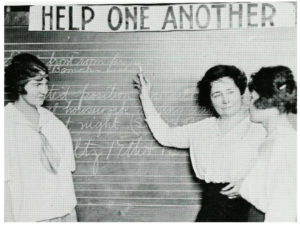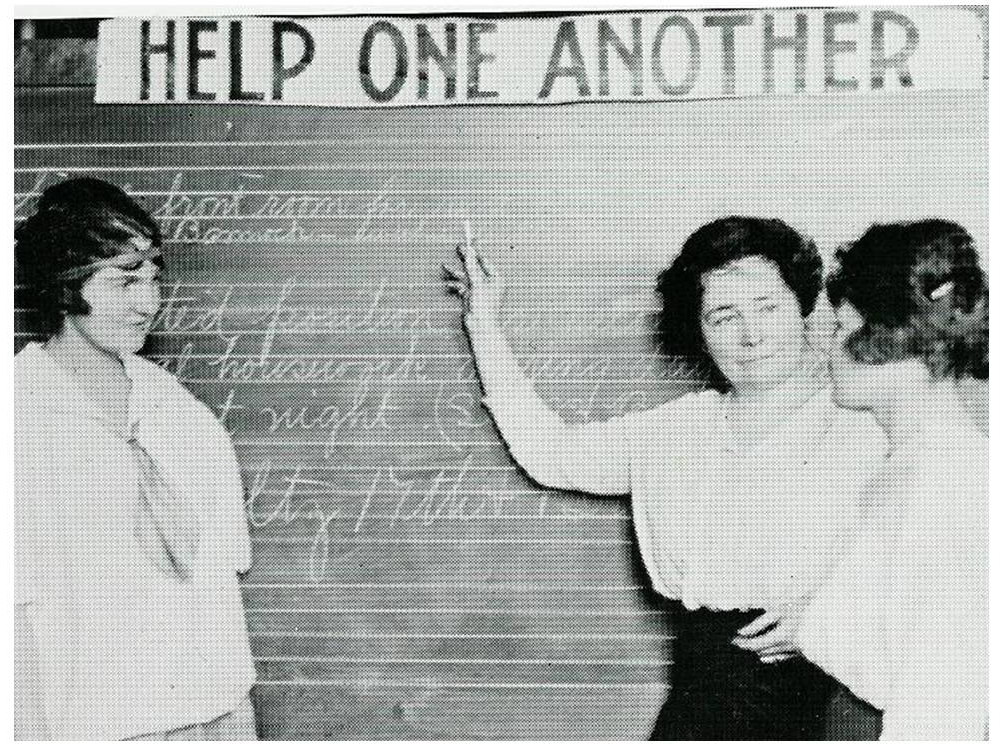
'For All Who Wish to Learn': An Education Model Worth Celebrating Turns 100

Emily Griffith at the blackboard. Image courtesy of Emily Griffith Technical College
I teach because I believe in the power of education to change a life. What keeps me working and serving at the community college level is the deep understanding that education is a right that should be afforded to all people, including nontraditional students who are first-generation, immigrants, or of low socioeconomic status.
These students are, statistically speaking, least likely to connect with the opportunities and privileges of postsecondary education. In many ways, they are the ones who are best served by this access. I am not alone in this belief. Along with many others, I stand on the shoulders of an education giant: Emily Griffith.
Emily Griffith was a frontier teacher who saw how language barriers, poverty limited education opportunities
Long familiar with the name, I knew little about Emily Griffith and the technical school she founded until recently. Now, on the year of their 100th anniversary, there is an excellent opportunity to reflect on Griffith’s life, her school’s mission, and the people they serve. Her tremendous personal story serves as the backdrop for her school’s mission and work.
Born into a poor family, Griffith was teaching in a sod schoolhouse in Nebraska by the age of 16. Her teaching experience gave her contact with students’ families, whom she found were in need of their own adult-level education due to limited educational opportunities, poverty, or immigrant status. Seeing the needs of the population she served, Griffith developed the dream of a school open to every age and labeled “Opportunity.”
Telegraphy and English lessons: In 1916, the Opportunity School gave everyone a chance for a better life through learning
This dream became a reality in 1916 in Denver, Colorado. While Griffith hoped for around 200 students to enroll, 1,400 people registered at her Opportunity School in the first week of its existence. Its inaugural programs included telegraph operation and English for non-native speakers.
By Griffith’s retirement in 1933, the institution had served more than 100,000 students and was renamed the Emily Griffith Opportunity School in her honor — and over her objections. As the years passed, it expanded its programs to include classes in auto repair, office administration, cosmetology, upholstery and specialized training for soldiers and civilians during both world wars.
Griffith’s education model counteracted a nativist movement that parallels contemporary anti-immigration views
Emily Griffith opened its doors amidst a nativist movement that is very similar to the anti-immigration stances we hear from candidates during this election season. However, Griffith understood from experience that for immigrant students and their families to thrive, diverse and readily available educational offerings had to become a reality.
The school that bears her name still works within this educational model. In a time of declining college enrollment and families who struggle to find (and repay) financial aid, a system that supports nontraditional and immigrant students is one that more education institutions should consider.
Today’s Emily Griffith Technical College stays true to the motto ‘For All Who Wish to Learn’
Today, the school, now called Emily Griffith Technical College, remains a public, non-profit institution. It intentionally reaches out to and supports one of the most diverse student bodies of any post-secondary school in the nation. Its contemporary programs include:
- Adult basic education and GED studies
- Water quality management
- English language acquisition
- Workplace, customer service and supervisory skills
- Creative arts and design
- Health sciences
- Apprenticeship training programs in areas including ironwork, carpentry and bricklaying
The school’s motto, “For All Who Wish to Learn,” communicates its commitment to a racially and socioeconomically diverse student population of varied ages and educational backgrounds. On its 100th birthday, Emily Griffith celebrates having served 1.6 million students, but many more lives have been touched by the school open to all.
Education that is open to all is a long-term success strategy
President Barack Obama’s vision of free education at two-year schools extends Emily Griffith’s philosophy of increasing learning opportunity for all. As we wait for this idea to come to fruition, community education, GED, and certification programs can and should be supported as a strategy for long-term success in our schools.
These models should be seen, as Emily Griffith saw them, as open to all, available to all, and, finally, as a benefit to all. On the school’s 100th birthday, let’s take this opportunity to thank Emily Griffith Technical College for creating such an environment.
Monica Fuglei is a graduate of the University of Nebraska in Omaha and a current faculty member of Arapahoe Community College in Colorado, where she teaches composition and creative writing.
Categorized as: Current Events
Tagged as: Adult Learners, Career and Technical Education
